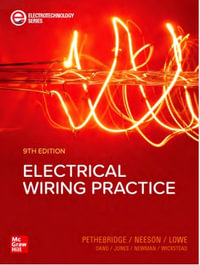| Contents | p. V |
| Preface | p. XI |
| Introduction | p. 1 |
| What is voltage stability? | p. 1 |
| Voltage Collapse Incidents | p. 4 |
| Two Bus Example | p. 5 |
| Derivation for critical voltage and critical power | p. 7 |
| Q-V curves | p. 11 |
| Discussion on PV and QV Curves | p. 12 |
| Maximum power and power flow Jacobian | p. 15 |
| References | p. 16 |
| Numerical Bifurcation Techniques | p. 19 |
| Various Types of Bifurcation | p. 19 |
| Bifurcation of Dynamical Systems | p. 22 |
| Center manifold | p. 24 |
| Detection of Bifurcation Points | p. 26 |
| Static bifurcations | p. 26 |
| Homotopy Method | p. 27 |
| Continuation methods | p. 30 |
| Curve Tracing | p. 32 |
| Direct method in computing the Saddle node bifurcation point: a one step continuation | p. 38 |
| Hopf Bifurcation | p. 40 |
| Existence of Hopf bifurcation point | p. 40 |
| Direct methods | p. 41 |
| Indirect methods | p. 42 |
| Complex Bifurcation | p. 42 |
| References | p. 45 |
| Continuation Power Flow | p. 49 |
| Introduction | p. 49 |
| Locally Parameterized Continuation | p. 49 |
| Formulation of Power Flow Equations | p. 50 |
| The Predictor-corrector Process | p. 51 |
| Selecting the continuation parameter | p. 53 |
| Identifying the critical point | p. 53 |
| Examples | p. 54 |
| Simultaneous Equilibria Tracing in Power Systems | p. 75 |
| Total solution at an equilibrium | p. 76 |
| Traditional approach | p. 76 |
| Power Flow Methodology and Assumptions | p. 77 |
| Nonlinearity in power flow | p. 78 |
| Slack bus assumption | p. 79 |
| PV bus assumption | p. 80 |
| Total Power System Equilibria Solutions | p. 81 |
| Formulation of power system DAE model | p. 82 |
| Synchronous generators | p. 82 |
| Excitation Control system | p. 83 |
| Prime mover and speed governor | p. 84 |
| Nonlinear load model | p. 85 |
| LTC model | p. 86 |
| Other models | p. 86 |
| Network power equations | p. 89 |
| Power system DAE model | p. 90 |
| Bifurcation modeling of power system dynamics | p. 90 |
| Saddle-node bifurcation | p. 91 |
| Hopf bifurcation | p. 91 |
| Manifold models in power systems | p. 92 |
| Manifold | p. 92 |
| Natural parameterization | p. 93 |
| Local parameterization | p. 93 |
| Equilibrium manifold Tracing of power systems | p. 95 |
| Initialization for power system equilibrium tracing | p. 96 |
| Continuation method with local parametrization | p. 98 |
| Linerization of power system DAE | p. 99 |
| Detection of Saddle Node Bifurcation with System Total Jacobian | p. 100 |
| Detection of saddle-node bifurcation | p. 101 |
| Limits implementation | p. 104 |
| Governor limits | p. 104 |
| AVR limits | p. 104 |
| Numerical examples for EQTP | p. 108 |
| References | p. 115 |
| Sensitivity Analysis for Voltage Stability | p. 117 |
| Introduction | p. 117 |
| Given State Based Indices | p. 117 |
| Large Deviation Based Indices | p. 120 |
| Stability Studies via Sensitivity Analysis | p. 120 |
| Identification of critical elements | p. 121 |
| Eigenvalue sensitivity | p. 121 |
| Modal analysis | p. 122 |
| Sensitivity analysis via CPF | p. 123 |
| Tangent vector, right eigenvector, and right singular vector of J | p. 124 |
| Voltage stability index from the tangent vector | p. 125 |
| Sensitivity analysis from the tangent vector | p. 127 |
| Bus sensitivities | p. 127 |
| Branch sensitivities | p. 129 |
| Generator sensitivities | p. 131 |
| Qualitative vs. quantitative sensitivities | p. 133 |
| Margin Sensitivity | p. 133 |
| Transfer margin estimation | p. 136 |
| Multi-parameter margin sensitivity | p. 138 |
| Sensitivity formulas | p. 139 |
| Test System Studies | p. 142 |
| Two bus example | p. 142 |
| The New England system | p. 147 |
| Exciter parameters | p. 147 |
| Network parameters | p. 149 |
| Load (scenario) parameters | p. 151 |
| Multiple-parameter variations | p. 153 |
| References | p. 154 |
| Voltage Stability Margin Boundary Tracing | p. 157 |
| Introduction | p. 157 |
| Natural Parameterization for Margin Boundary Tracing | p. 158 |
| Load parameter space | p. 158 |
| Control parameter space | p. 159 |
| Formulation of Margin Boundary Tracing | p. 160 |
| Margin boundary manifold of power system | p. 160 |
| Characterization of margin boundary | p. 160 |
| Characterization of saddle node bifurcation related margin boundary tracing | p. 160 |
| Margin boundary tracing | p. 161 |
| Augmentation for bifurcation characterization | p. 161 |
| Augmentation for local parameterization | p. 162 |
| Basic Steps Involved in the Margin Boundary Tracing | p. 164 |
| Practical implementation | p. 164 |
| Implementation of reduced method | p. 165 |
| Examples | p. 167 |
| Series compensation between bus 6 and bus 31 | p. 176 |
| Shunt Compensation | p. 176 |
| Multiple contingencies | p. 177 |
| Boundary tracing with respect to generation control parameters | p. 178 |
| Load margin vs adjustment of Ka of AVR system | p. 178 |
| Load margin versus adjustment of V[subscript ref] of AVR system | p. 179 |
| Control combination | p. 180 |
| Advantages of margin boundary tracing | p. 181 |
| Formulation of Voltage Stability Limited ATC | p. 181 |
| Scenario Parameters | p. 184 |
| Scenario According to Simultaneous Multi-area Transactions | p. 185 |
| Determination of K [subscript Li] | p. 187 |
| Determination of K [subscript Gi] | p. 190 |
| Numerical Example | p. 191 |
| Description of the simulation system | p. 191 |
| Emergency transmission load relief | p. 201 |
| Single transaction case | p. 201 |
| Simultaneous transaction case | p. 202 |
| Reactive power Support | p. 202 |
| Single transaction case | p. 202 |
| Simultaneous transaction case | p. 203 |
| Control combination | p. 204 |
| Conclusion | p. 205 |
| References | p. 206 |
| Time Domain Simulation | p. 207 |
| Introduction | p. 207 |
| Explicit and Implicit Methods | p. 208 |
| Explicit method | p. 208 |
| Implicit method | p. 209 |
| Stiffness and Numerical Stability | p. 209 |
| Decoupled Time Domain Simulation | p. 212 |
| Numerical Examples | p. 217 |
| Two bus system | p. 217 |
| New England 39-bus system | p. 223 |
| Quasi-Steady-State Simulation (QSS) | p. 226 |
| Problem Formulation | p. 227 |
| Steps involved in QSS Method | p. 228 |
| Implementation of the Continuation Method in QSS | p. 230 |
| Consideration of Load Change with respect to Time | p. 230 |
| Numerical Results | p. 232 |
| 2-bus system | p. 232 |
| CQSS Simulation for New England 39-bus system | p. 233 |
| References | p. 236 |
| Appendix | p. 239 |
| Data of 2-bus test system | p. 239 |
| One line diagram | p. 239 |
| The IEEE format: Base case power flow data of the 2-bus system | p. 239 |
| The dynamic data of the 2-bus system | p. 240 |
| Data of New England test system | p. 241 |
| One line diagram | p. 241 |
| The IEEE format: Base case power flow data of the New England system | p. 242 |
| The Dynamic Data of the New England System | p. 245 |
| Index | p. 249 |
| Table of Contents provided by Ingram. All Rights Reserved. |
























